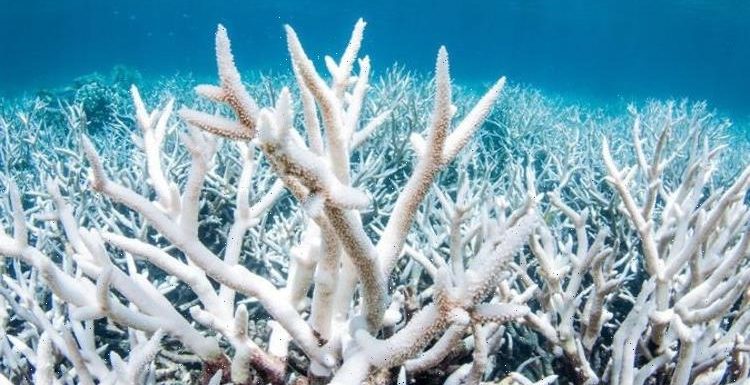
Great Barrier Reef ‘at risk of losing heritage status’ reveals expert
We use your sign-up to provide content in ways you’ve consented to and to improve our understanding of you. This may include adverts from us and 3rd parties based on our understanding. You can unsubscribe at any time. More info
Scientists have captured on video the moment the Great Barrier Reef exploded into life during a so-called coral spawning event. The annual coral spawn only occurs between October and December and sees the natural wonder off the coast of Queensland, Australia, release billions of sperm and eggs. The event was witnessed last week just off Cairns, in what has been hailed a positive sign of regeneration by the endangered reef.
Marine biologist Gareth Phillips, who witnessed the breathtaking phenomenon, said: “Nothing makes people happier than new life – and coral spawning is the world’s biggest proof of that.”
Due to the effects of global warming and climate change, scientists around the world have warned the Great Barrier Reef’s future is in jeopardy.
Coral reefs are extremely sensitive to changes in water temperature and acidity caused by the absorption of carbon dioxide (CO2), which can lead to so-called coral bleaching.
Bleaching occurs when stressed corals lose the algae that give them their vibrant colours.
According to the World Wide Fund for Nature (WWF), climate change is the leading cause of coral bleaching worldwide, but pollution, low tides and too much sunlight can also contribute to coral death.


The WWF warned: “Coral bleaching matters because once these corals die, reefs barely come back.
“With few corals surviving, they struggle to reproduce, and entire reef ecosystems, on which people and wildlife depend, deteriorate.”
Data published by the US National Oceanic and Atmospheric Association (NOAA) indicates about 75 percent of the world’s corals experienced heat stress severe enough to trigger bleaching between 2014 and 2017.
And for about 30 percent of the reefs, the heat stress was considered bad enough to kill the corals.
Scientists are, consequently, thrilled to see the Great Barrier Reef reproduce.
Dr Dean Miller, marine biologist and director of the Great Barrier Reef Legacy, branded the phenomenon the “best coral spawning event and the most encouraging moment” seen at the reef since 2016.
He told News.com.au: “I liken it to an underwater blizzard or snowstorm in reverse, everything is coming up from the bottom where the corals are, and floating to the surface.
“You are surrounded by millions if not billions of individual coral eggs and sperm of all different colours.”
According to the expert, the process is extremely effective and has “created the largest living structure” on Earth.
He added: “To have a successful spawning event means the reef is in a state of recovery and repair.


“This is how the Great Barrier Reef regenerates.”
However, the expert added the reef is “certainly not out of the woods” just yet.
The Great Barrier Reef is composed of more than 2,900 individual reefs and hundreds of islands that stretch over a 344,400 square kilometre area.
Situated in the Coral Sea, off the northeast coast of Australia, the reef has been a UNESCO World Heritage site since 1981.
But the reef is under threat from climate change and has already experienced five mass bleaching events – in 1998, 2002, 2016, 2017 and 2020 – as a result of rising ocean temperature.
Scientists have recently warned that even if global warming is limited to 1.5C, the reef would still experience worrying levels of bleaching up to three times a decade.
A study published in the journal Global Change Biology warned tropical coral reefs are among the ecosystems most sensitive to climate change.
Study co-author Peter Mumby of the University of Queensland said: “It tells us that even with the most optimistic scenarios, we are still looking at one bleaching event somewhere every three years.”
Source: Read Full Article